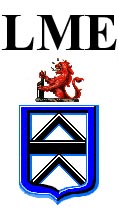 |
| Home Page |
| About Me |
|
|
| New Projects |
| The Shop |
|
|
| Equipment |
| Steam Engines |
| Gas Engines |
|
|
|
|
| Links |
| E-Mail! |
| Family Crest |
Arms and Crest of Lamborn
| Ar., a
Fesse between two Chev., sa. Crest, a Demi-Lion Rampant gu. supporting
the rudder of a ship, sa.
[ Explanation: Ar., silver or white; Fesse, a belt; Sa., sable black; Chev., chevron; Demi, the half; (in Heraldry the head or top part is always understood when no other is mentioned); Rampant, standing erect on sinister hind leg; Gu., gules, red.] The various branches of the Lamborn family by intermarriage are indicated by the same arms, but differently decorated. The one above selected seems to be the original and worn by Sir William Lamborn, Eleanor, daughter and heir of Sir William by the heiress of Ralph le Soore, of Talverne, by Mabel his wife, sister and co-heir of Sir Maurice Berkeley, married Sir John Arundel, a Knight of Lanherne, county of Cornwall.----Burk's History of the Commoners. "The shield - the most important piece of their defensive armor - was derived by the knights of the middle ages from remote antiquity, and at almost all times it has been decorated with some device or figure. The ancient Greek tragedian, Eschylus (about B.C. 600) describes with minute exactness the devices that were borne by six of the seven chiefs who, before the Trojan war, besieged Thebes. The seventh is specially noted to have been unchanged; and in the middle ages in Europe there prevailed a precisely similar usage. Indeed, so universal was the practice of placing heraldic insignia upon the shield, that the shield has been retained in modern heraldry as being inseparable from all heraldry; so it still continues to be the figure upon which the heraldic insignia of our own times are habitually charged. "The coat of arms is a complete and distinctive heraldic composition. The expression is evidently derived from the medieval usage of embroidering the armorial insignia of a noble or a knight upon the surcoat, jupon or tabard which he wore over his armor. "The crest is a figure or device independent and complete in itself, worn by the knights of the middle ages upon their helms and basinets. Crests are exclusively the heraldic of men. "The lion - the king of beasts - is the animal which, as a charge of heraldry, has always been held in the very highest estimation. He appears in the heraldic blazonry under the most varied conditions and in association with almost every other device. It was not only the favorite beast with the early heralds, but also almost the only one that they introduced into their blazon; and they considered that the natural attitude for the lion was rampant - erect, looking intently before him towards his prey, and preparing to make his formidable spring. "Heraldry was employed in the feudal ages to display the exploits of chivalry, and to reward as well as commemorate the triumphs over oppression and violence, amidst the imperfections of uncultivated eloquence and a general ignorance of written language. The ensigns of heraldry were peculiarly significant; they addressed the imagination through a more direct channel and in a more striking manner than words could do; while at a glance they recalled the most important events in the history of individuals, families and nations. Their immediate relation to warfare and the honorable distinctions arising therefrom linked the past closely with the present. Exhibited on the shields and accouterments of warriors, they also adorned the habiliments of peace, and were often transferred to more durable materials to perpetuate the memory of those who bore them. They were the chief ornaments in the palaces of the great; selected by painters as models; set up in courts of judicature, and stamped on the nation's currency. Thus to the utmost limit of their signification did armorial bearings become the symbolical language of Europe. "Originally the crest was an ornament worn chiefly by kings, knights and warriors upon their helmets, made either of feathers, wood, leather or metal, and secured by the 'wreath' - a parti-colored fastening consisting of the principal metal and color of the shield intertwined. Being no longer thus borne, the art of the painter, sculptor and engraver must be employed to gracefully represent on the precious metals, wood canvas, stone, paper, or other materials, that which was more rudely and terribly displayed in the past ages. "Armorial bearings may be and frequently are rendered with a view to giving beautiful effects, and thus please unscientific observers. This practice deserves severe censure. They should be presented with such minute care and precision as to satisfy those who are skilled in the science, who demand mot pictorial beauty, but exactness of detail in representing blazonry, and thus give truthful information as to the character and exploits of those to whom they were granted. "In the ages of the past the crest enjoyed the place of honor, in many cases being the sole bearing; and, by one of those coincidences so frequently met with, the same place appears by general consent to be again assigned to it." |
|
|
